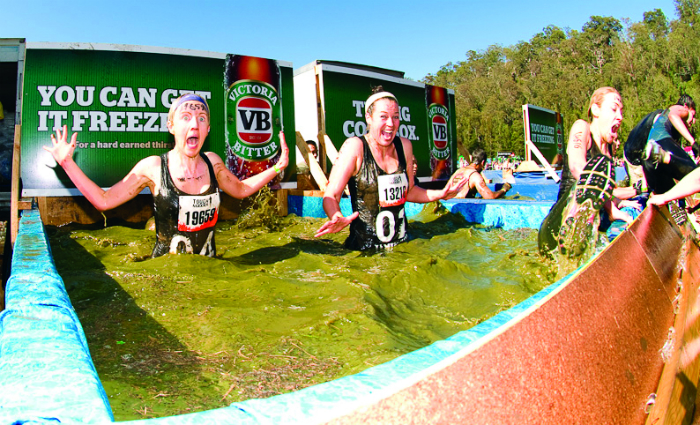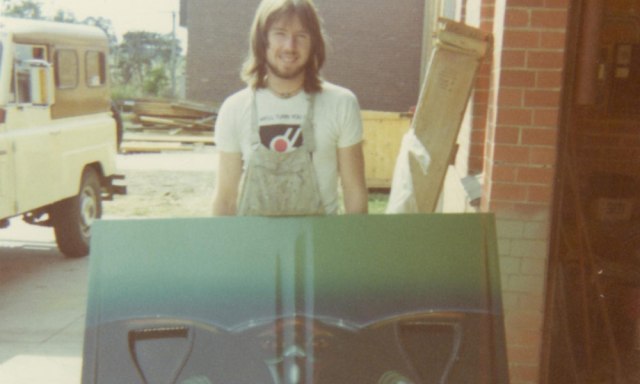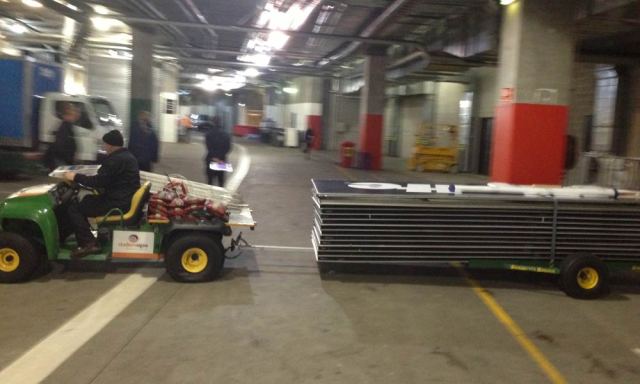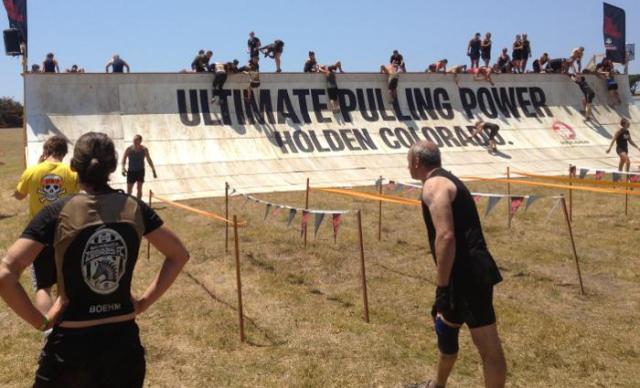
From a small, highly skilled outfit that pumped out the product, Stadium Signs has evolved into a savvy player in the signage supply market, and a trusted marque with mindshare among corporate clients and ad agencies in the competitive major events industry.
In the early days of Stadium Signs, the sign that Pamela Hammond, one of the company’s two co-directors recalls most vividly is the one stating: ‘I’m at the MCG’.
It had been fixed to the front entrance by her co-director and partner Leigh Onions – but far from relaxing at a cricket test, Onions was navigating between clients and the iconic ‘G’, the company’s main install site – over time it was becoming a breakneck pace.
In fact, when ProPrint called at Stadium Signs at Ferntree Gully in Melbourne’s outer east, the snappy pace seemed at odds with a languid first working week back after the New Year. The Test/Big Bash cricket season is still a red zone for the company, but not nearly as frantic as it had been in the early days, says Hammond. “There was plenty of work, but we were just treading water, and we were dangerously reliant on one huge client, the MCG.”
Back in 1988, Onions, a trained signwriter, versed in the skills of hand sign painting had bought Bradley Signs, a small company at Ferntree Gully, which happened to have a client who had a contract to produce six signs for the MCG. Onions began developing a lucrative relationship with the MCG, changing the company name to Stadium Signs and moving into the growing technology of digital printing. That MCG link later became the anchor around which a number of small, dynamic signage markets began to revolve.
“Leigh was busy focusing on the work at hand and it would take somebody else to work on the business and grow it into the next phase,” reflects Pamela Hammond, who came on board in 2009 after a long and industrious career in film and TV.
“I came into a company in which there was just Leigh, his longstanding project manager Luke Brady and one apprentice, who were coping with the massive MCG account,” she explains, adding that the cricket and AFL seasons created two periods of hyperactivity on the calendar, separated by a lull.
“My aim was to try to even things out a little more, and attract business to fill the void and introduce efficiencies that would make the down periods more productive.”
She points to high-level rethinking – such as strategically shifting the company ‘from being reactive to pro-active when it comes to drawing in new business’. For example, the pair were in Perth last October to supply signage for the Tough Mudder 20km obstacle-course event in the West and while there, they presented their credentials to a number of prospective clients.
The aim also was to move away from depending almost solely on MCG events for its business. Today Stadium Signs produces a wide range of bespoke products and experiential branding for clients such as MCG, Cricket Australia and a host of event companies.
Hammond says that in the four-and-a-half years since she came on board, Stadium has rebranded, developed a new website, launched a Facebook page, and there is now a busy calendar of networking – on a national level, and in its local catchment area of the eastern suburbs of Melbourne.
STRATEGY
“Our key strategy is to be a trusted partner to our clients and our policy is to under promise and over deliver – every time,” she reflects. “We try to obtain all the business of the clients we work with. For example, someone from Renault Australia came to us once with an order to print decals for helmets to be worn in a promotional driving event. We treated that as more than a single order – we talked to them about our company and eventually we were introduced to key people and now we do a wide range of signage for Renault.”
These have included the 2013 Ride of the Lions, in which a number of ex-British and Irish Lions and ex-Australian Wallabies rugby union players ride their bikes 1,000km with guests to raise funds for Walking with the Wounded and Redkite between the second and third rugby tests of the Lions Tour of Australia in June-July last year. Renault Sport donated the use of five vehicles for the charity event and Stadium Signs fully wrapped the vehicle graphics. During ProPrint’s visit, work was underway on vehicle wraps for the Renault Clio “So Frenchy So Chic” campaign whilst artwork was being prepared for the ANZ Tennis Shuttle bus.
Stadium’s recent projects have included vehicle wraps of Mr Whippy vans for the Australian Open, an Adidas laneway tennis promotion in the Melbourne CBD, the Carlton Dry signs for the Mile High 4 Star World Snowboard Event at Perisher, NSW, and the VB and Holden Colorado signage and installation for all six Australia-wide Tough Mudder events. They were also recently commissioned to design and build the AAMI helipad stage with Ipad plinths for Derby Day for the insurer’s ongoing ‘Rhonda and Ktut’ campaign.
Sometimes sheer innovation wins the day. Pamela Hammond shows a sign for Australian winemaker Tempus Two for Portsea Polo which Leigh Onions designed – instead of a steel post, it features a rubber coated polymer post that bends back and forth if accidentally walked into at turf carnivals, preventing injuries.
What the co-directors emphasise is that Stadium Signs is now very much a project management company, accessing its resources from a network of trade printers, finishers and installers – for a versatile range of signage and event-related products.
These include bespoke signage solutions, fabric media backdrops, sports and stadium signage, corporate signage, vehicle wraps and banners, in fact, everything their client requires to gain wide exposure during their events.
Stadium Signs runs a Mimaki JV5 160S 1.6m eco-solvent inkjet printer for printing in-house with a lot of its larger signage being trade printed on a Durst Rho 550GT and Océ Arizona 360 UV flatbed, owned by one of its partner print outfits, says Leigh Onions. Finishing is done on a number of machines, including an inhouse Mimaki CJV30 cutter laminator.
Much of Stadium’s larger format print and finishing work is outsourced, explains Hammond, whose previous background is project managing post-production in the film industry. “As they do in film, our business plan is to access the resources we need rather than buy expensive equipment in.
“We want to avoid adding in a $500,000 machine that’s going to be used twice a week. Acquiring capital equipment for all the printing requirements of these varied types of products would not be the best way to go. We didn’t want to become the type of company that installs the latest and greatest printing and cutting equipment, and then scrambles to fill spare capacity on the presses to pay it off.
“We prefer to work within a reliable network of printers and other suppliers who are there for us, often on a round-the-clock basis in this fast moving sector, and we’re all benefiting from the increased business,” Hammond explains.
TRAINING
For its seven full-time staff, now based at a spacious facility at Ferntree Gully into which Stadium moved two years ago, there has been workplace training with a business coach, workshops and weekend staff seminars for team building and leadership training. “We asked our staff what parts of their jobs they really liked, and what parts they considered stressful, then realigned our positions to both suit the business and our life/work balance.” Needless to say this is an ongoing project.
The rethink also included other tweaks, such as a new delivery-vehicle fleet and new quoting and job software, right down to the creature comforts around the premises like a coffee machine and comfortable, spacious staff amenities that make Stadium Signs a happy work environment.
Part of the company’s present-day productivity stems from its innate understanding of the campaign cycle. Hammond says planning begins ‘four-to-five months’ out from a campaign launch, around the time the client books a ‘footprint’ at the event. Stadium is now very much a partner with agencies and clients, working in an integral way on the aims and goals of campaigns, taking a whole of concept approach rather than passively waiting for the print order.
“One of the most time consuming phases of a project can be artwork approvals, and we work closely with our clients to ensure that this time is reduced. Sometimes it takes weeks to obtain final art approval and only hours to produce. Closer to the event start date, detailed electronic proofs are issued, and once these are approved, the printing and install work begins.
“Our emphasis is not only on speed but on quality, as we’re dealing at the corporate level. We source our media, printing, finishing and builds locally,” says Hammond, and this gives Stadium Signs an edge over brokered solutions that often use cheap alternatives imported from low-wage manufacturing markets.
One suspects that Pamela Hammond , Leigh Onions and the Stadium Signs staff live for the adrenalin of the event-industry signage game. Clients expect printing, installs and de-installs to run like clockwork.
For example, when the Australian cricketers’ success meant the Boxing Day Test finished early, the couple were on a drive some 90 minutes from the MCG when they received the phone call to begin the de-install. A quick U turn followed — and plans for a carefree day during the Christmas break suddenly changed. “It’s not good enough to say ‘we’ll attend to it tomorrow’,” she says. “They expect the signage removed when they say they want it removed so they can start rejuvenating the turf.”
There are plenty of traps for the unwary in the pacey world of event signage – hazards that a competitor here and there have run into have included supplying the wrong marquees, using the wrong materials or sizes and not showing up on time. And in the jumbo world of event signage, the errors are naturally also of scale, so avoiding them is essential. That is especially so in such a highly competitive market.
Hammond sums it up: “Major sporting and entertainment events give sponsors the opportunity to reach as many as 100,000 people on that special day. The client only gets one chance to make an impact and it’s our role to make sure that the products we supply are top quality, correct and arrive on time.”
FACTFILE
Established 1988
Staff numbers 7
Location Ferntree Gully, Victoria
Comment below to have your say on this story.
If you have a news story or tip-off, get in touch at editorial@sprinter.com.au.
Sign up to the Sprinter newsletter



